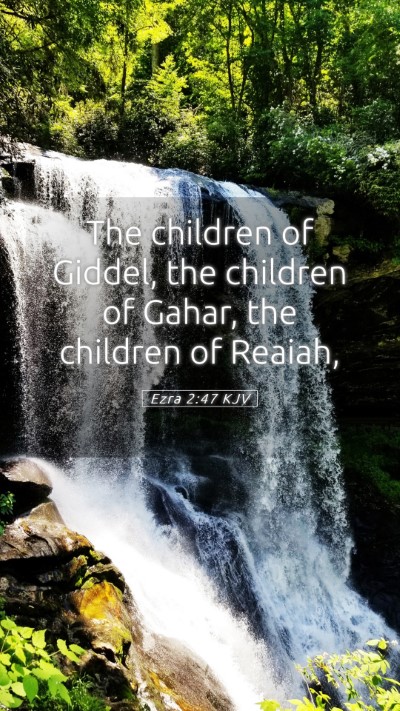Bible Verse Commentary on Ezra 2:47
Verse Reading: Ezra 2:47 states, "The children of the porters: the children of Shallum, the children of Ater, the children of Talmon, the children of Akkub, the children of Hatita, the children of Sobai, in all a hundred thirty and nine."
This verse lists the names and numbers of the porters (or gatekeepers) who returned to Jerusalem with the exiles from Babylon. It highlights the importance of this role in the re-establishment of the community of Israel in their homeland.
Understanding Scripture: Insights from Commentaries
Matthew Henry's Commentary
Matthew Henry emphasizes that the list of returning exiles is significant as it showcases the organization and structure of the community being reformed. The porters played a vital role in the hierarchy of the temple, maintaining order, and protecting the sanctity of worship. He notes that the listing of names serves to honor those who were committed, showing God’s provision for His people even in the mundane duties of life.
Albert Barnes' Notes
Albert Barnes points out that the porters were essential for the maintenance of the temple’s integrity. The number mentioned, 139, though seemingly small, reflects a community-focused structure essential for the temple’s functionality. Barnes stresses that these roles remind us of the necessity of every position within the church and community, no matter how humble, in serving God’s purpose.
Adam Clarke's Commentary
Adam Clarke highlights the specific families of porters, elaborating on their responsibilities. He explains that the roles of these individuals were not only crucial for physical security but also symbolically represent the spiritual watchfulness required to guard the community. Clarke’s examination brings forth the historical context of porters’ duties in biblical times, linking it to the present-day Church, where every member has a role to play.
Thematic Insights
The overarching theme in Ezra 2:47 relates to the restoration and rebuilding of God's people after exile. The mention of specific families shows that God remembers names, individual histories, and positions within His people. The verse contributes to a larger narrative of hope, restoration, and the significance of community involvement in fulfilling God's plans.
Related Biblical Themes
- Community and Service: The importance of serving within the community is a recurring theme in Scripture.
- Divine Order: God’s structure for His people reflects His nature; thus, every role is vital.
- Faithfulness: Those who returned showed faithfulness in the face of hardship.
Cross References
- Nehemiah 11:19 - Details of the gatekeepers in Jerusalem.
- 1 Chronicles 9:22-27 - A history of the gatekeepers' duties.
- Psalm 84:10 - The significance of serving in God’s house.
Application in Daily Life
Understanding this verse can lead to meaningful reflection on the roles we play within our own communities. Just as the porters were necessary for the functioning of the temple, individuals today are called to unique positions within their families, churches, and various societal structures. Recognizing the importance of every contribution fosters unity and purpose in our endeavors to live out God's calling.
Conclusion
Ezra 2:47 serves as a reminder of the importance of every role within the body of believers. From public ministers to those who perform seemingly small duties, each person's contribution is vital for the flourishing of the community. In our Bible study groups, we encourage the examination of each person's role and significance, drawing inspiration from the faithful return of the exiles who understood their importance in God's plan.
Further Study
For deeper understanding, consider using Bible study tools to explore the context of Ezra and its themes of restoration and community. Utilizing online Bible study resources can enhance personal and group discussions, shedding light on how ancient practices inform modern faith practices.


